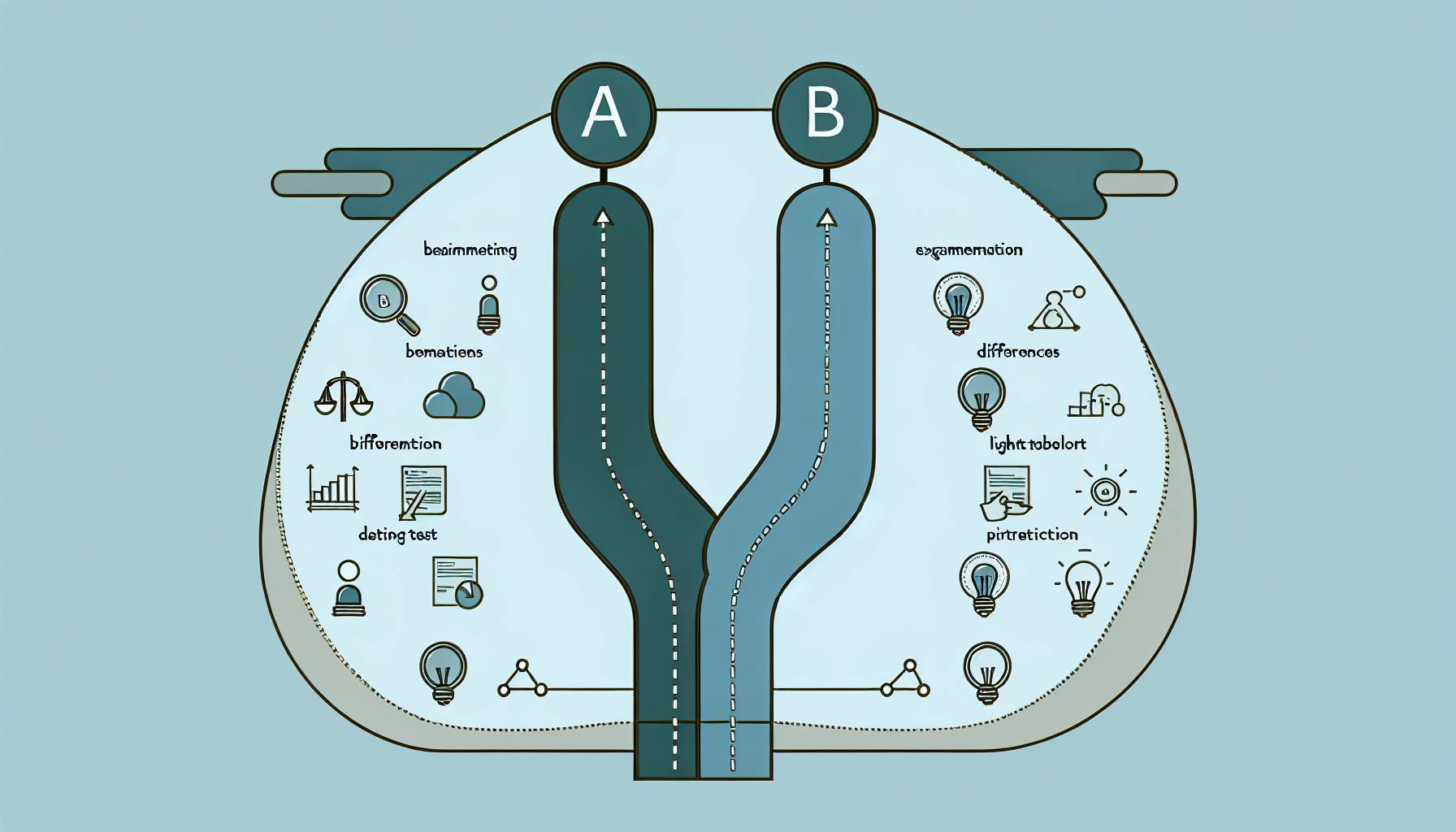Finding the right data science or engineering role can be confusing given their overlapping responsibilities.
In this post, we'll clearly define the roles and responsibilities of data scientists versus data engineers to help guide your career choice.
You'll see key differences in day-to-day work, technical skills, salaries, and more to determine which role best fits your strengths and interests.
Unraveling the Interplay of Data Science and Data Engineering
Data science and data engineering are two distinct yet complementary fields that work together to enable data-driven decision making. While there is some overlap in skills and responsibilities, they play unique roles in the data pipeline.
Exploring the Data Science Career Path: From Data Analysis to Predictive Modeling
Data scientists focus on using statistical methods and machine learning to extract meaningful insights from data. Key responsibilities include:
- Statistical analysis and modeling to uncover patterns and trends
- Building predictive models using machine learning algorithms
- Data visualization to effectively communicate insights
- Presenting findings to stakeholders to influence business decisions
Aspiring data scientists often start as data analysts or business analysts before specializing in more advanced statistical and machine learning methods. With some additional skills in programming and cloud technologies, data scientists can advance to lead roles directing analytics and AI initiatives.
The Role of a Data Engineer in System Architecture and Data Pipelines
Data engineers develop and maintain the infrastructure that collects, stores, processes, and serves data to downstream consumers like data scientists. Their key responsibilities include:
- Designing and implementing data pipeline architecture
- Building and optimizing data warehouses and lakes
- Managing large-scale databases and cloud data infrastructure
- Creating data ETL and processing systems
- Ensuring high data quality and accessibility for analytics
Skills in programming, system operations, and infrastructure management are crucial for data engineers. Knowledge of SQL, Python, Hadoop, Spark, and cloud platforms like AWS is also important. With their specialized infrastructure skills, data engineers provide the foundation for data scientists to unlock deep insights.
While their day-to-day responsibilities differ, effective collaboration between data scientists and data engineers is key to executing impactful data analytics initiatives in organizations.
What are the roles of data engineering?
Data engineers build and maintain the systems for collecting, validating, and preparing high-quality data that data scientists then use to drive business decisions. Their key responsibilities include:
-
Designing and implementing data pipelines to move data from various sources into data warehouses or lakes. This requires skills in SQL, Python, Spark, Airflow, dbt, etc.
-
Building out infrastructure on platforms like AWS, GCP or Azure to store the data at scale. This involves provisioning resources, optimizing costs, ensuring scalability and high availability.
-
Enforcing data quality, security and governance through testing, monitoring, access controls and data cataloging. This enables trust in the data.
-
Supporting data scientists by providing clean, reliable data in a timely manner. Data engineers collaborate closely with data analysts and scientists to understand their data needs.
In summary, data engineers focus on constructing and managing the foundational data infrastructure, while data scientists concentrate more on advanced analysis and modeling using that data. Both roles are critical to effectively leveraging data at scale.
Who makes more data engineers or data scientist?
Data engineers and data scientists are both integral roles in the data analytics field that work closely together, yet there are some key differences between them.
Data engineers focus on building and maintaining the infrastructure for data pipelines and architecture. They are responsible for developing, deploying, monitoring and optimizing data storage systems, processing pipelines, databases and tools. Key responsibilities include:
- Designing and implementing data pipelines, architectures and systems
- Building infrastructure for ETL, data processing and storage solutions
- Developing data warehouses, data lakes and databases
- Creating processes for data modeling, mining and collection
- Establishing data security, compliance and governance
Meanwhile, data scientists utilize this infrastructure to uncover insights and communicate findings to stakeholders. They employ statistical, analytical and machine learning techniques to derive value from data. Typical data science duties include:
- Performing advanced analysis and statistical modeling with data
- Applying machine learning algorithms for predictive analytics
- Visualizing and presenting data insights to business teams
- Making recommendations for operational improvements and innovation
- Staying updated on latest data analytics methodologies
In terms of compensation, data engineers tend to earn a higher average salary compared to data scientists. According to recent industry salary reports, average pay stands at:
- Data Engineer: $137,000
- Data Scientist: $121,000
The specialized infrastructure and architectural skills data engineers possess are scarce and highly sought-after. However, data scientists also continue to see high demand as organizations increasingly rely on advanced analytics. Both roles work closely together and require an overlap of technical abilities around data and analytics.
What are different roles and responsibilities of data scientist?
Data scientists have a wide range of responsibilities that focus on extracting insights from data. Some of their key duties include:
Data Collection and Preparation
- Identifying valuable data sources and datasets
- Building processes and pipelines to collect, integrate, clean, and transform data from disparate sources
- Ensuring quality and integrity of data for analysis
Exploratory Data Analysis
- Performing initial investigations on data to uncover patterns, trends, and relationships
- Using statistical analysis and data visualization tools to analyze dataset properties
- Determining the appropriate data modeling and mining techniques to apply
Modeling and Algorithm Development
- Selecting and applying machine learning algorithms (e.g., regression, classification, clustering) to train predictive models
- Optimizing models by experimenting with different algorithms and parameters
- Programming models and methods using languages like Python and R
Model Implementation and Monitoring
- Deploying models into production environments
- Writing code to share data insights with stakeholders
- Monitoring models to review accuracy and precision over time
- Maintaining models by retraining with new data
In summary, data scientists focus on unlocking actionable insights from complex data. Their multifaceted role combines computer science, analytics, math, and business acumen.
What is the difference between DA and DS?
Data Analysts and Data Scientists have overlapping yet distinct roles and responsibilities when it comes to working with data. Here is a high-level overview of the key differences:
Data Collection and Storage
Data Analysts are more focused on accessing, cleaning, and organizing data using SQL, Python, R, or GUI tools. Data Scientists may be involved in building data pipelines, architectures and infrastructure using technologies like Hadoop, Spark, cloud platforms etc.
Exploratory Data Analysis
Both conduct exploratory analysis to spot trends and patterns. Data Analysts rely more on pre-built visualization dashboards and reports. Data Scientists perform deeper multivariate analyses using statistical modeling and machine learning algorithms.
Model Development
Data Analysts occasionally develop basic models for forecasting and predictions. Data Scientists regularly develop more complex models using machine learning, deep learning and advanced statistical techniques.
Domain Expertise
Data Analysts tend to have business expertise in a specific domain like marketing, finance etc. Data Scientists require multidisciplinary skills - both data and domain expertise to uncover insights.
Software and Coding
While some analyst roles require SQL and basic coding, Data Scientists spend a substantial amount of time coding models in Python, R or other languages.
In summary, while there is an overlap in some data manipulation and analysis tasks, Data Scientists specialize in more advanced analytics and modeling capabilities using a variety of data science toolkits. The business impact a Data Scientist can drive tends to be higher.
sbb-itb-ceaa4ed
The Symbiosis of Data Science and Data Engineering in Data + Analytics
Data science and data engineering play complementary roles within the data lifecycle. While data scientists focus on advanced analysis to extract insights, data engineers build the infrastructure and pipelines that enable reliable storage and processing of large datasets.
Regression Analysis and Neural Networks in Data Science
Data scientists rely on statistical and machine learning techniques like regression analysis and neural networks to uncover patterns in data. However, quality infrastructure is required to facilitate this analysis.
Regression analysis involves developing models that describe relationships between variables. By running regressions on datasets, data scientists can quantify correlations. For example, a retail chain could use regression to determine how weather impacts sales of seasonal goods.
Neural networks are computing systems modeled after the human brain's network of neurons. They employ complex algorithms to recognize underlying relationships between input and output variables. Data scientists leverage neural networks for tasks like image recognition, natural language processing, and predictive modeling.
However, to train and test models like regressions and neural networks, data scientists need properly engineered databases and data pipelines. Reliable data infrastructure enables them to focus less on wrangling datasets and more on core analysis.
Data Engineering: Pioneering Big Data Systems with Hadoop and Pig
Data engineers build the databases, warehouses, pipelines and platforms that store and process high volumes of data. For instance, they develop big data systems using Hadoop and Apache Pig.
Hadoop is an open-source framework that allows distributed processing of large datasets across clusters. It is designed to scale up from single servers to thousands of machines, offering local computation and storage. This enables organizations to leverage vast amounts of data efficiently.
Pig is a high-level platform that runs on top of Hadoop for creating complex data transformations without extensive coding. Data engineers use it to build flexible ETL pipelines that load, clean, transform, and move data. This powers data science applications that derive insights.
By pioneering infrastructure for immense datasets, data engineers empower data scientists to focus less on data management and more on core analysis like statistical modeling. This symbiosis between the two roles drives impactful decision-making.
Technical Skills and Tools for Data Careers
We break down the key programming languages, frameworks, platforms and tools used by data scientists versus data engineers.
Data Science Tools: Python, R, SQL, and Visualization Tools
Data scientists rely on Python and R for building statistical models and machine learning algorithms to uncover insights from data. Proficiency in Python data science libraries like Pandas, NumPy, SciPy, and scikit-learn is key. R data science packages like ggplot2, dplyr, tidyr, and caret are also commonly used.
In addition to coding skills, data scientists need SQL knowledge to access and analyze databases. They use SQL queries to extract, transform, and load data for modeling. Visualization tools like Tableau, Power BI, and Matplotlib allow data scientists to clearly present data-driven insights to stakeholders.
Data Engineering Tools: SQL, Java, Scala, and ETL Processes
Data engineers focus on building and maintaining the infrastructure for data pipelines at scale. This requires expertise in SQL for data warehouse design and database management. Programming languages like Java, Scala, and Python are used for developing distributed systems that process big data.
A core responsibility is the ETL (Extract, Transform, Load) process. Data engineers use ETL tools like Informatica, Talend, Pentaho, etc. to pipeline data from sources into data warehouses or lakes for analysis. They also utilize workflow schedulers like Apache Airflow and build data APIs for easy access. Big data platforms like Hadoop, Spark, Kafka are commonly worked on.
With the massive data volumes involved, data engineers optimize system architecture, data modeling, and infrastructure performance. DevOps skills like Docker, Jenkins, and Kubernetes enable reliable deployments. Expertise across the data engineering tech stack is needed to build robust pipelines.
Charting Your Career in Data Science and Data Engineering
Data science and data engineering are two of the hottest career paths in tech today. Both fields offer the chance to work with cutting-edge technologies and solve complex problems that can impact business success. However, the day-to-day roles and responsibilities of data scientists versus data engineers can vary significantly.
Embarking on a Data Science Career Path: Education to Data Science Bootcamps
A data science career typically requires an advanced quantitative degree such as a Master's in Computer Science, Statistics, Mathematics or a related field. Coursework focuses heavily on statistical modeling, machine learning algorithms, Python programming, R programming, and SQL querying.
Many data scientists start their careers in analyst roles performing statistical analysis and building predictive models before specializing into more senior data science positions. Data science bootcamps are another common path for transitioning into junior data science roles.
Data scientists are responsible for extracting insights from data. Typical responsibilities include:
- Building machine learning models to make predictions and optimize decisions
- Performing statistical analysis to uncover patterns and quantify outcomes
- Developing data visualizations and dashboards to communicate findings
- Translating analysis into strategic business recommendations
- Staying updated on state-of-the-art data science techniques and tools
The average data scientist salary in the US is $117,288 per year, with senior data scientists earning over $150,000.
Navigating a Career in Data Engineering: From Software Engineering Perspectives to DevOps
Data engineers build and optimize the systems that allow data scientists to perform analysis. A Bachelor's degree in Computer Science, Software Engineering or a related technical field is common. Coursework emphasizes databases, data pipelines, cloud infrastructure, and programming languages like Python and Java.
Data engineers focus on constructing data pipelines to collect, transform, and store data at scale. Common responsibilities include:
- Building and maintaining big data pipelines with tools like Apache Spark, Kafka and Airflow
- Developing data warehouses and lakes on cloud platforms like AWS, GCP and Azure
- Creating data models and schema for downstream analytics
- Optimizing data processing performance and efficiency
- Automating and monitoring data pipelines with CI/CD and DevOps
- Collaborating with data scientists to produce analytics-ready datasets
The average data engineer salary is $102,472 in the US, with senior engineers earning $130,000+ per year.
Building Effective Data Teams: Data Scientists, Data Engineers, and Beyond
Data science and data engineering are complementary disciplines that together enable impactful data products. By combining their respective strengths in data modeling and system architecture, organizations can build high-performing data teams.
Complementary Skill Sets: Data Modeling and System Architecture
Data scientists excel at statistical modeling and analysis using tools like Python, R, and SQL. They have mathematical, statistical, and business expertise to build predictive models from company data that extract valuable insights.
In contrast, data engineers focus on building and optimizing data infrastructure. They are skilled with big data tools like Hadoop, Spark, and cloud platforms to ingest, process, store and serve data that data scientists can then analyze.
With data scientists building analytical models and data engineers providing the underlying data pipelines and infrastructure, the two roles work synergistically to create production-ready data products. Effective collaboration and communication between them is key for success.
Structuring Effective Teams: The Interplay of Data Science and AI
As companies adopt AI, roles like machine learning engineers and AI specialists are emerging. Integrating them into data teams requires some restructuring.
Here are some best practices:
-
Data scientists should partner with ML engineers to translate analytical models into production-grade AI services.
-
Data engineers provide the data infrastructure and tooling to power the machine learning models and workflows.
-
AI specialists focus on optimizing model performance and output.
-
Encourage open communication channels between the roles to streamline hand-offs.
-
Consider combining data science and engineering into one team under a Head of Data to facilitate tight collaboration.
With the interplay between data science and AI, striking the right team balance and structure is key to building impactful data products. Encouraging partnership between roles and domains leads to synergies that amplify overall output.
Conclusion: Synthesizing the Roles of Data Scientists and Data Engineers
Data scientists and data engineers play complementary roles in building data products and driving business value. Here is a summary of their key responsibilities:
Data scientists focus on extracting insights from data through statistical modeling, machine learning, and advanced analytics. Their key duties include:
- Identifying business problems that can be solved with data analysis
- Collecting, cleaning and organizing data from disparate sources
- Performing exploratory data analysis to uncover patterns and trends
- Building predictive models and machine learning algorithms
- Validating models and quantifying their accuracy
- Communicating data insights to key stakeholders with visualizations and presentations
Meanwhile, data engineers build and maintain the infrastructure data scientists rely on. Their primary responsibilities involve:
- Architecting scalable data pipelines and workflows
- Building platforms for data cleaning, integration, and storage
- Providing tools and infrastructure that data scientists can easily utilize
- Automating repetitive data related tasks
- Ensuring optimal data quality and accessibility for analytics
While their skillsets differ, data scientists and engineers work together to transform raw data into actionable business insights. Organizations need personnel in both roles collaborating effectively to fully capitalize on their data assets. With robust data pipelines feeding advanced analytics models, companies can use data to guide strategic decisions and create competitive advantages.


